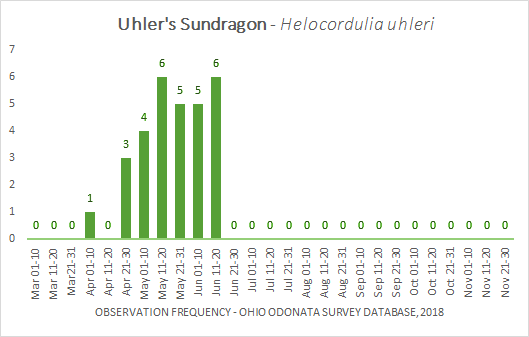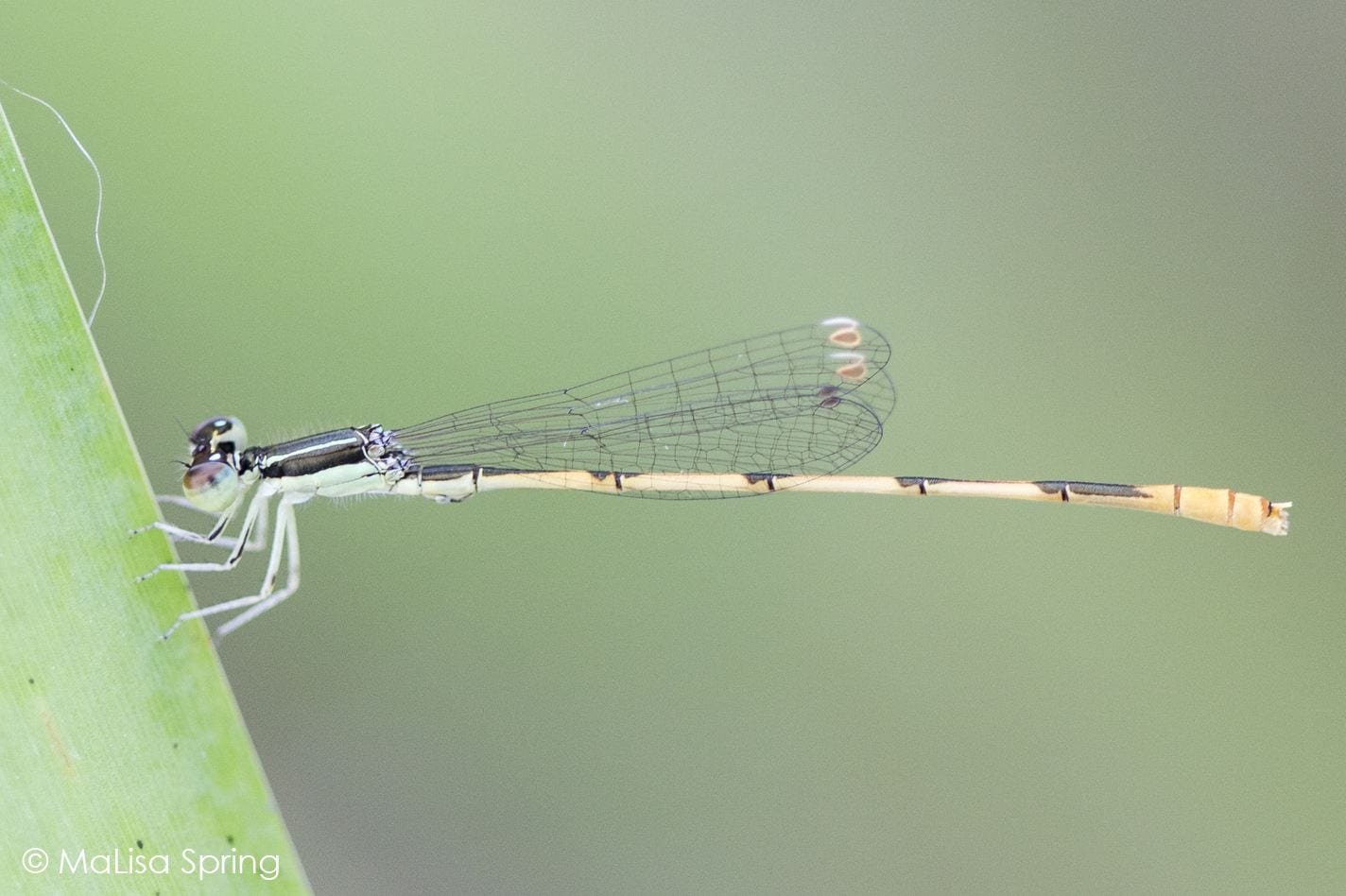Spring Dragons – What to Expect in March – April in Ohio
What cool records will we find this year? One of the challenging things about dragonflies and damselflies is that some species are seasonal. We have some species that start showing up in April and fly all year long. Other species have only been documented in May, rarely found afterwards.
Thus, this blog is to help you target the April/May species and make sure you don’t miss out on the ones with short flight dates. We do have a list of complete flight dates along with a separate page for 2018 Ohio species maps [update: now combined]. It also wouldn’t hurt to review the locations you can access and try to document dragonflies.
Now, onto our early season dragons.
Almost every year, our earliest recorded adult is the Common Green Darner, Anax junius. It is a known migratory species, so we are likely enjoying the wave of adults as the move northward from their winter home. This Blue/Green dragon is known to taunt photographers and collectors alike. Aside from really cool days, it rarely lands and instead flies at impressive speeds, able to dodge most net and camera wielding naturalists. In 2018, our earliest records were on April 5th, followed by many people documenting them mid and lat April.
They can be challenging to document, but if you take the time to pan with the Common Green Darner, you can sometimes get a somewhat clear shot. However, we accept and appreciate any blurry photos, as these are still identifiable in their mostly blur images.
Flight chart for all historical records in Ohio. As you can see by their flight chart, the Common Green Darner shows up early, but has highest populations midsummer.
The Blue Corporal (Ladona deplanata), was also documented on April 5th by Sheree Cyra-Moorman, but it wasn’t reported again until May 1st. If you are in central or southern Ohio, this is a species to watch.
The Blue Corporal is listed as State endangered, but we have been able to document many in the last two years. Will you find one?
Flight Chart of all historical Ohio Records. The Blue Corporal is a true spring species, rarely being documented past May. Make sure to visit clear, deep lakes in May to get a nice image of this State Endangered Species!
Our next species to be reported in Ohio was the Eastern Forktail (Ischnura verticalis), by Sarah White on April 21st in Montgomery County. Our dates this year will depend on the weather, but start looking once we have had a few days of 60s in a row.
Not a perfect image, but you can at least see the main patterns used to identify the Eastern Forktail. The males have green thoracic stripes and two segments of blue at the end of their abdomen.
The Eastern Forktail has one of our longest flight periods. It emerges early and flies late.
In 2018, it was not until the end of April that a Fragile Forktail (Ischnura posita) was first reported. Similar in size to the Eastern Forktail, the Fragile Forktail does not have the blue at the end of the abdomen and has a broken thoracic stripe.
Fragile Forktails are found close to most aquatic habitats, often seen flying around in the grass near ponds and lakes.
In 2018, we also had Uhler’s Sunddragon (Helocordulia uhleri) reported at the end of April in Adams County. This southern stream species is listed as State Endangered, so it is a rare find. It looks very similar to a Common Baskettail (Epitheca cynosura), but has more black at the base of the wings and a slight widening of the abdomen near the middle.
We have only documented Uhler’s Sundragon in April and May. Fingers crossed that we can find this at the Ohio Dragonfly Conference in Southern Ohio this year.
Then, at the beginning of May, we start getting a lot more species emerging.
Our first Southern Spreadwing (Lestes australis) was observed by Jim Lemon on May 2nd. The first Carolina Saddlebags (Tramea carolina) was documented by Sarah White on May 4th. The first Painted Skimmer (Libellula semifasciata), was also documented by Sarah White on May 4th. Kim Smith spotted another Painted Skimmer the next day in Lucas County, ~170 miles north of the first observation. So as soon as the first southern person reports one, I would not be surprised to also see them being reported in northern Ohio.
Painted Skimmers are similar to Halloween Pennants, but have less orange in the wings. The Painted Skimmer abdomen is also black in the center and orange along the edges, compared to the Halloween Pennant, which has black edges and orange/yellow in the center of the segments.
By May 5th, we had reports of Swamp Darners (Epiaeschna heros) in Ottawa County (northern Ohio). By May 6th, we had our first reported Citrine Forktail (Ischnura hastata) at Cox Arboretum in Montgomery County, again by Sarah White.
Male Citrine Forktails are somewhat easy to ID if you can see them. Their abdomen is mostly orange with green thoracic stripes. Their small size makes them otherwise hard to notice.
Also on May 6th, we had our first reports of Springtime Darners (Basaieschna janata) in Logan County by Danielle Hodges and Jim Lemon. True to it’s name, it emerges in the spring.
The Springtime Darner can be tricky to document without first netting it and carefully holding it by the wings. In addition to the blue on the abdomen and green thoracic stripe, the Springtime Darner has characteristic brown at the base of the wings that helps differentiate it from other darners.
By May 9th, we have lots of observations of the above species and our first observation of the Ebony Jewelwing (Calopteryx maculata) in Summit County. Then finally on May 10th, Jim Lemon spots a teneral Common Whitetail (Plathemis lydia) emerging in Champaign County. By May 10th, Sarah White recorded the first of the year records for Wandering Gliders (Pantala flavescens), Blue Dashers (Pachydiplax longipennis), Orange Bluets (Enallagma signatum), and Skimming Bluets (Enallagma geminatum). Also on May 10th, Jon Cefus and Kent Miller documented the first Stream Cruiser (Didymops transversa) of the year! Finally, on May 11th, MaLisa Spring documents the first Ohio records of Aurora Damsel (Chromagrion conditum) and Common Baskettail (Epitheca cynosura) in Vinton County. By May 12th, we have our first Ohio reports of Twelve-spotted skimmers (Libellula pulchella) and Black Saddlebags (Tramea lacerata) in Warren County. May 12th also brings our first report of Double Striped Bluets (Enallagma basidens) in Montgomery County, Ohio by Sheree Cyra-Moorman (who also spotted Black Saddlebags that day).
The Double Striped Bluets are small and somewhat easily overlooked. True to their namesake, they have an extra stripe on their thorax, breaking up the black with a thin blue stripe.
In 2018, May 13th was our first day we had reports of Azure Bluets (Enallagma aspersum) in Franklin County by Alisa DeMatteo. Jim Lemon also spotted the first Eastern Red Damsel (Amphiagrion saucium) in Champaign County on May 13th. By May 15th, we have our first report of a Familiar Bluet (Enallagma civile) along with a Pronghorn Clubtail (Phanogomphus grasilenellus) in Greene County by Sarah White. Jim Lemon also spots a Familiar Bluet in Shelby County, and Jim also spots the first Violet Dancer (Argia fumipennis) in Miami County and the first Eastern Pondhawk (Erythemis simplicicollis) in Shelby County. In Lorain County on May 15th, we have our first of the year Ohio record for the Dot-tailed Whiteface (Leucorrhinia intacta). In Champaign County on May 15th, Alisa DeMatteo found both the First Of the Year and first county record since 1934 for the Band-winged Dragonlet (Erythrodiplax umbrata). (A different population was known from Northeastern Ohio in 2006 and 2007, with only two other reports in the state, once in 2014 in Lorain County and again in 2018 on the 4th of July in Ottawa County by Ryan Jacob. Regardless, this is a great find that only shows up rarely in Ohio.)
That is enough records for now. The above species should give you an idea of what you might expect in the next month or so. Look out for part 2, which will list the First Of the Year 2018 records for the latter half of May. The key takeaway from the above is that once the species is mentioned, we then begin to see lots of people reporting them. So if they are spotted once somewhere in the state, expect them to be out and flying in other parts of the state in short order.
-Malisa Spring













